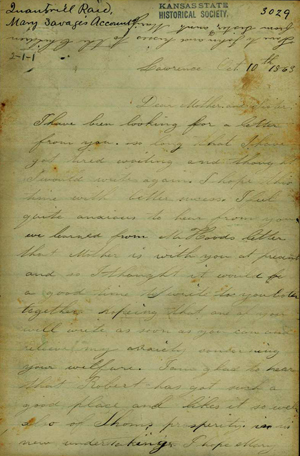A massive, collaborative digitization project underway at the Kansas City Public Library has brought together a unique collection of documents from 25 institutions scattered across Kansas and Missouri. Among the 6,000 pages of digitized materials (which in early-2013 will be made available on civilwaronthewesternborder.org) are numerous letters written in the aftermath of William Clarke Quantrill’s infamous guerilla raid on Lawrence, Kansas in the early morning hours of Friday, August 21, 1863.
Two weeks after the raid, Lawrence resident Sarah Fitch wrote of the tragedy to her in-laws, telling them, “I have been trying to summon strength to write to you all the particulars of the sad, sad day which has brought such gloom to this once happy place.” She went on to describe the night before the raid, during which she and her husband walked back home together from a store and kissed their children goodnight. The family awoke to the sounds of gunshots at sunrise. Fitch described the scene as one the ruffians entered her home:
that demon – who was there swearing – shouting – screaming – in our dear little parlor, with his revolver cocked in one hand – the matches lighted to fire our home in the other – I felt there was no mercy there – oh my friends – do you wonder in that instant – (for all passed much more quickly than I can write it) – that my heart almost stopped its beating – and in utter despair, I almost doubted if there was a God who loved us
The raiders coldly shot Sarah’s husband, Edward, then burned the house to the ground with his body still inside.
Sarah Fitch, whose transcribed letter resides at the Watkins Community Museum of History in Lawrence and will appear on the library’s website, did not grieve alone. The raiders killed as many as 192 men and boys, while sparing women and younger children. The violence against male civilians shocked the nation for its scale and sheer audacity, but its brutality was hardly unique along the Missouri-Kansas border during the Civil War years.

Other letters in the library’s new digital collection include a pair written by Mary Savage and now held by the Kansas Historical Society in Topeka. Savage, resident of Lawrence, wrote to her mother and sister on October 10, 1863, and then to another acquaintance, Jane Simpson, on November 29. Happily, Savage’s husband escaped the fate of Edward Fitch by a method many of the male survivors had in common: hiding in a corn field. (A more famous example is Senator James H. Lane, who had himself led the brutal sacking of Osceola, Missouri two years before and found refuge in the corn during Quantrill’s Raid).
Mary Savage wrote of her attempt to flee town in a carriage with her husband, Joseph, and of witnessing a neighbor and fellow church-goer gunned down before their eyes. Joseph, Mary wrote, “comprehended the whole thing in a moment and jumping from the buggy was over the fence and into the cornfield in a second, while I sat almost stupefied with horror at the scene before me.” Joseph went on to live a long life and gained regional distinction as an amateur geologist with the Kansas Academy of Science.
On the day of the raid, Mary bravely went to the aid of Mr. Langley (the unfortunate neighbor), who had been shot through the throat, but the man died the next morning. She did manage to put the fire out in Langley’s home prior to Mrs. Langley returning home to find her husband mortally wounded. As Mary saved the Langleys’ house, many other courageous Lawrence women saved their own homes and their husbands or sons by hiding them in their homes and then putting out the fires set by Quantrill’s Raiders, even as the raiders threatened to shoot the women for interfering with the destruction.
These letters, along with thousands of other documents that will be easily accessible to the public, are a surviving testament to the tragedy of the Civil War in Kansas and Missouri.
